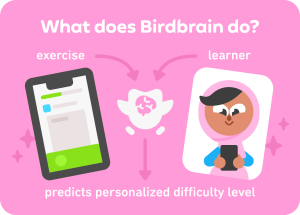The Brain Behind Your Lessons
Duolingo’s Aritificial Intelligence (AI) engine, Birdbrain, powers a personalization system that adapts to each learner’s journey. Having experienced both traditional classroom pacing and AI-driven adaptation, I’ve seen how this technology creates a more responsive learning environment. By analyzing performance patterns and predicting potential stumbling blocks, it crafts a unique learning path for every user—something my Chinese tutor did naturally, but that was impossible in my high school Spanish classes of 30 students.

When Machines Write Your Language Exercises
The platform now uses generative AI to create exercises, explanations, and dialogues, dramatically expanding its content library. As someone who has spent countless hours with traditional textbooks for French self-study, I appreciate the variety AI brings. However, I’ve noticed that while AI-generated content offers quantity, it sometimes lacks the natural flow I experienced with my human Chinese tutor.
Playing with AI
At its core, Duolingo uses AI to keep users engaged through clever gamification. Having used both free and premium versions, I’ve experienced how the AI-driven engagement features compare to traditional motivation methods. While my Saturday Chinese classes relied on personal accountability, Duolingo’s notifications and rewards create a different kind of commitment. But this raises an important question: Are we building genuine language skills, or just chasing digital rewards?
Your AI Language Partner and Cultural Embassador
Virtual learning assistants represent Duolingo’s latest AI innovation, offering conversation practice and instant feedback. After experiencing both AI chatbots and real-time conversations with my Chinese tutor during COVID, I understand both the potential and limitations of AI language partners. While they’re available 24/7, they still struggle with nuanced human interactions, such as humor and cultural context behind the language that are essential for meaningful communication..
This is something I aimed to address in Clíncia Voz, which integrates cultural competency to help healthcare professionals learn medical Spanish with an awareness of the diverse Latino and Hispanic communities they serve. While these AI tools can generate grammatically correct responses, they struggle with regional dialects, idiomatic expressions, and the subtle social cues that shape communication. Without cultural context, language learning becomes more mechanical, leaving learners with gaps in real-world application.

The Bottom Line of AI Learning
As both a language learner and developer, I’ve seen how AI helps platforms like Duolingo maintain profitability while scaling education. AI enables companies to automate content creation, personalize learning experiences, and drive engagement, all while reducing costs. However, recent AI-driven staff reductions at Duolingo raise important questions about balancing technological efficiency with human expertise—something I’ve come to value deeply through my various learning experiences. Removing experienced language professionals from the equation risks lowering the depth and quality of instruction in favor of scalable content generation.
Finding the Sweet Spot
Duolingo’s AI-driven approach has made language learning more accessible and engaging, but it also raises important concerns about accuracy, retention, and the role of human expertise. AI personalizes learning paths, but does it truly help learners develop deep, meaningful communication skills, or does it just optimize for continued engagement?
As we stand at this intersection of artificial intelligence and language education, perhaps the real question isn’t whether AI can replace human teachers, but rather how we can harness its power to create more meaningful, effective, and culturally rich learning experiences. In the end, the future of language learning may not be about choosing between human and artificial intelligence, but about finding innovative ways to bring out the best in both.

